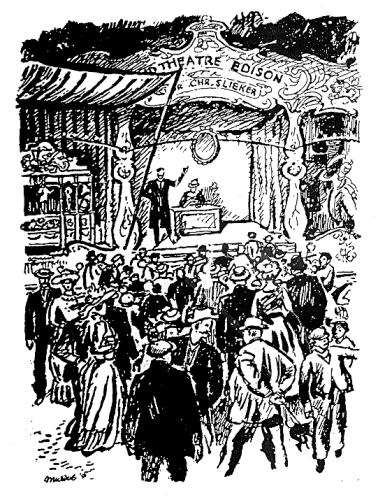Gestoorde Hengelaar on:
[Wikipedia]
[Google]
[Amazon]
''Gestoorde hengelaar'' (English: Disturbed Angler) was the first Dutch fictional film,Zwijgend en verloren; De Nederlandse stomme film geïnventariseerd
, NRCboeken, June 13, 1997)The First Dutch Film: Gestoorde hengelaar
, EYE Film Institute NetherlandsGestoorde hengelaar
, EYE Film Institute Netherlands made by
, EYE Film Institute Netherlands in 1896 and was produced by the studio ''Eerst Nederlandsch Atelier tot het vervaardigen van Films voor de Bioscoop en Cinematograaf van M.H. Laddé en J.W. Merkelbach''.Eerste Nederlandsch Atelier tot het vervaardigen van Films voor de Bioscoop en Cinematograaf M.H. Laddé & J.W. Merkelbach
, EYE Film Institute Netherlands
 The short silent film was first shown by the traveling cinema ''Grand Théatre Edison'' of Christiaan SliekerGeorge Christiaan Slieker (1861-1945)
The short silent film was first shown by the traveling cinema ''Grand Théatre Edison'' of Christiaan SliekerGeorge Christiaan Slieker (1861-1945)
Utrecht Project (archive) The film was not preserved and no known photos were taken of it. That means that it is a lost film. It is only known that ''Gestoorde hengelaar'' was a
, NRCboeken, June 13, 1997)The First Dutch Film: Gestoorde hengelaar
, EYE Film Institute NetherlandsGestoorde hengelaar
, EYE Film Institute Netherlands made by
M.H. Laddé
M.H. (Machiel Hendricus) Laddé (5 November 1866 – 18 February 1932) was a Dutch photographer and film director. He was the director of the first Dutch fictional film, the 1896 comedy ''Gestoorde hengelaar'' (English: ''Disturbed Angler'').< ...
M.H. Laddé, EYE Film Institute Netherlands in 1896 and was produced by the studio ''Eerst Nederlandsch Atelier tot het vervaardigen van Films voor de Bioscoop en Cinematograaf van M.H. Laddé en J.W. Merkelbach''.Eerste Nederlandsch Atelier tot het vervaardigen van Films voor de Bioscoop en Cinematograaf M.H. Laddé & J.W. Merkelbach
, EYE Film Institute Netherlands

 The short silent film was first shown by the traveling cinema ''Grand Théatre Edison'' of Christiaan SliekerGeorge Christiaan Slieker (1861-1945)
The short silent film was first shown by the traveling cinema ''Grand Théatre Edison'' of Christiaan SliekerGeorge Christiaan Slieker (1861-1945)Who's Who of Victorian Cinema
''Who's Who of Victorian Cinema'' is a reference work on film pioneers by Stephen Herbert and Luke McKernan, British scholars of film history. Originally published by the British Film Institute in 1996 as a reference book, the content has been revi ...
on Sunday 29 November 1896 in the ''Parktuin Tivoli'' in Utrecht.De eerste filmvertoning in Utrecht: Christiaan Slieker in Park TivoliUtrecht Project (archive) The film was not preserved and no known photos were taken of it. That means that it is a lost film. It is only known that ''Gestoorde hengelaar'' was a
slapstick
Slapstick is a style of humor involving exaggerated physical activity that exceeds the boundaries of normal physical comedy. Slapstick may involve both intentional violence and violence by mishap, often resulting from inept use of props such a ...
comedy scene (with Lion Solser and Piet Hesse, who were then popular Dutch comedians) from the flyer which Slieker distributed.
The film was shown in Slieker's cinema using a cinematograph
Cinematograph or kinematograph is an early term for several types of motion picture film mechanisms. The name was used for movie cameras as well as film projectors, or for complete systems that also provided means to print films (such as the Cin ...
, made by ''H.O. Foersterling & Co'' from Berlin, Germany. A fairground organ provided music during the film's showing.
See also
* List of Dutch films before 1910References
Sources
* A. Briels, Komst en plaats van de Levende Photographie op de kermis. Een filmhistorische verkenning, Assen (1973), p. 30 * K. Dibbets & F. van der Maden (red.), Geschiedenis van de Nederlandse film en bioscoop tot 1940, Weesp (1986), p. 19 *G. Donaldson, Of Joy and Sorrow. A Filmography of Dutch Silent Fiction, Amsterdam (1997), p. 51External links
* {{M.H. Laddé 1896 films Dutch black-and-white films Dutch silent short films Dutch comedy films Films about fishing Films shot in the Netherlands Films set in the Netherlands Lost Dutch films 1896 comedy films 1890s lost films Lost comedy films 1896 short films Silent comedy films Silent adventure films